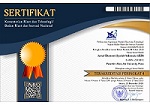Portrait Implementation Muzara’ah Contract Effort Encourage Improvement Community's Economy
Abstract
The purpose of this study is to describe how the process of implementing profit sharing is carried out by agricultural communities in the District. District Anggeraja. Enrekang and whether the profit-sharing model is following the muzara’ah contract in Islam. There are three main topics discussed in this article, namely (1) The potential for shallot farming (2) The mechanism for implementing the muzara’ah contract in shallot farming (3) The economic impact on the community from shallot farming. This type of research uses qualitative methods which are described descriptively. Sources of research data using primary data and secondary data. To obtain valid data, the authors use data collection methods utilizing observation, interviews, and documentation. The data analysis technique used in this research is data reduction, presenting data, and drawing conclusions. The findings of the results in the study indicate that the concept of profit sharing is carried out by the people of Kec. Anggeraja Kab. Enrekang is called by the term bagessele' which is carried out based on the customs of the local community, namely an agreement between the owner of capital and sharecroppers in the form of an oral statement. In the process of implementing shallot farming profit sharing, all the results obtained from agriculture are totaled as a whole, then reduced by the capital that has been issued, and then divided based on the proportion between sharecroppers and capital owners. The mechanism for implementing the profit sharing used is also following the principles of Islamic law in Ramallah because it refers to the pillars and conditions that have been fulfilled. The distribution of ratios also follows the proportion of profit sharing in the muzara’ah contract, namely ½, 1/3, and ¼ following the mutual agreement.
Keywords
Full Text:
PDFReferences
Abdullah;Fasiha, M. R. (2014). Pengantar Islamic Economics (E. Rustan (ed.)). Lumbung Informasi Pendidikan.
Abdullah, M. R. (2017). Bagi Hasil Tanah Pertanian (Muzara’ah) (Analisis Syariah dan Hukum Nasional). Al-Amwal : Journal of Islamic Economic Law, 2(2), 148–172. https://doi.org/10.24256/alw.v2i2.636
Amelia, S. (2018). Tinjauan hukum islam terhadap praktek bagi hasil dalam muzara’ah. Universitas Islam Negeri Sultan Maulana Hasanuddin Banten Oleh:
Antonio, M. S. (2001). Bank syariah: dari teori ke praktik. In Gema Insani (1st ed.). Gema Insani Pres.
Astuti, L. T. W., Daryanto, A., Syaukat, Y., & Daryanto, H. K. (2019). Analisis Resiko Produksi Usahatani Bawang Merah pada Musim Kering dan Musim Hujan di Kabupaten Brebes. Jurnal Ekonomi Pertanian Dan Agribisnis, 3(4), 840–852. https://doi.org/10.21776/ub.jepa.2019.003.04.19
Bonita, S. D., & Anwar, A. Z. (2017). Implementasi Syariah Compliance pada Akad Murabahah dan Ijarah ( Studi Kasus pada KSPPS BMT Fastabiq Jepara ). 88 Silvia Dora Bonita, Aan Zainul, VII(2), 88–97. https://doi.org/http://dx.doi.org/10.21927/jesi.2017.7(2).90-99
Chaidir Iswanaji, Aziz muslim, M. Z. N. H. (2022). Ijarah Collaborative Service Model In Sharia Banking. Indonesian Interdisciplinary Journal of Sharia Economics (IIJSE), 5(2), 702–718.
Dahrum, & Logawali, T. (2016). Penerapan Sistem Muzara ’ Ah Dalam Meningkatkan Kesejahteraan Masyarakat Di Kelurahan Palampang. Iqtisaduna, 2(2), 15.
Hakim, L. (2012). Prinsip-Prinsip Ekonomi Islam (Novietha;Sallama (ed.); 1st ed.). Erlangga.
Husna, N. (2018). Implementasi Akad Mudharabah Pada Petani Bawang Merah (Studi Pada Desa Pandang Batu Kecamatan Baraka Kabupaten Enrekang). Skripsi UIN Alauddin Makassar, 66.
Kartiko, A. (2019). Konsep Bagi Hasil Dalam Perspektif Islam. Indonesian Interdisciplinary Journal of Sharia Economics, 2(1), 1–19. https://doi.org/https://doi.org/10.31538/iijse.v1i3.268 KONSEP
Khasanah, U. (2009). Sistem Bagi Hasil Dalam Syariat Islam. De Jure: Jurnal Hukum Dan Syar’iah, 1(2). https://doi.org/10.18860/j-fsh.v1i2.332
Kurnia, T., & Aziz, I. A. (2022). Implementasi Akad Muzara’ah Dalam Meningkatkan Pendapatan Buruh Tani Di Desa Sukaharja. ALMUJTAMAE: Jurnal Pengabdian Masyarakat, 2(1), 56–64. https://doi.org/10.30997/almujtamae.v2i1.5442
Mardani. (2012). Fiqh Ekonomi Syariah (Pertama). Prenadamedia Group.
Maulana, D. (2021). Faktor-faktor Penghambat dan Resiko Pertanian Bawang Merah Terhadap Hasil Panen Para Petani Di Desa Kecipir Kecamatan Losari Kabupaten Brebes. In IAIN Syekh Nurjati Cirebon. IAIN Syekh Nurjati Cirebon.
Nita, S. V. (2020). Kajian Muzara’ah dan Musaqah (Hukum Bagi Hasil Pertanian Dalam Islam). Jurnal Qawanin, 4(2), 236–249.
Panorama, S. Y. T. (2017). Transaksi Ekonomi dan Bisnis dalam Tinjauan Fiqh Muamalah. In Idea Press (1st ed.). Idea Press Yogyakarta.
Prasetyo, N. (2021). Implementasi sistem akad muzara’ah dalam meningkatkan kesejahteraan petani (studi kasus: bagi hasil di desa sukorejo kecamatan gandusari kabupaten trenggalek). IAIN Tulung Agung.
Raco, J. R. (2010). Metode penelltlan kualltatlf: jenis, karakteristik, dan keunggulannya (a. L (ed.); pertama). PT Grasindo.
Rafly;Natsir;Sahara. (2016). Muzara’ah (Perjanjian Bercocok Tanam) Lahan Pertanian Menurut Kajian Hukum Islam. Jurnal Hukum Islam, 11(2), 220–228. https://doi.org/https://doi.org/10.33059/jhsk.v16i2
Suparman, S., Oruh, S., & Agustang, A. (2021). Dinamika Sosial Kelompok Tani (Studi Kasus Petani Bawang Merah Desa perangian Kecamatan Baraka Kabupaten Enrekang). JIIP - Jurnal Ilmiah Ilmu Pendidikan, 4(6), 406–414. https://doi.org/10.54371/jiip.v4i6.298
Sutrisno, H. A. K. J. (2019). Respon Pemberian Pupuk Mikrobat Dengan Berat Umbi Berbeda Terhadap Pertumbuhan dan Produksi Tanaman Bawang Merah (Allium ascalonicum L). Jurnal Ekonomi Pertanian Dan Agribisnis, 4(1), 24–29. https://doi.org/10.35329/agrovital.v4i1.321
Syah, D. (2020). Suatu Tinjauan Hukum Tentang Bagi Hasil Atas Tanah Pertanian Antara Pemilik Tanah Dengan Petani. Jurnal Ilmiah Metadata, 1(3), 127–146. https://doi.org/10.47652/metadata.v1i3.Usmani, M. M. T. (1998). an Introduction to Islamic Finance (1st ed). Idaratul Ma’arif.
DOI: http://dx.doi.org/10.21927/jesi.2023.13(1).82-92

This work is licensed under a Creative Commons Attribution-ShareAlike 4.0 International License.












